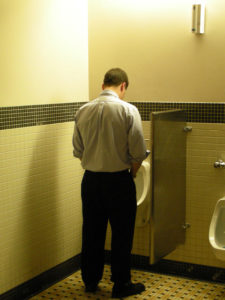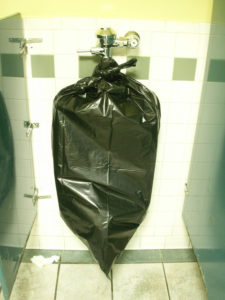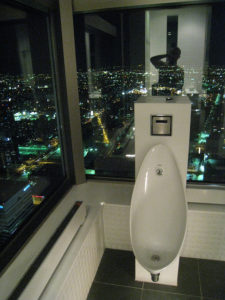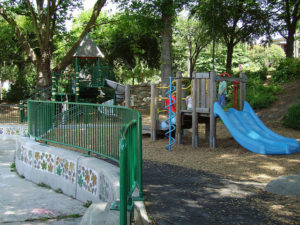The Problem of Society Usage of Public Restrooms
Public communities are crafted by landmarks of public properties which allows themselves to interact with not only the facilities, but also with one another. This in essence constructs a invisible, but crucial web known as the relationships of communities. This presence influences how people can trust and rely on one another; but after the introduction of the internet and social media, more people are attracted to the online community while leaving the regular public facilities to be uncared for. Because of this absence, many who ignore these faculties are struck with surprise when they come to use it, only to realize how disorganized it has become in such short time. Public restrooms in particular has many concerns by the government due to the outdatedness of their design and unregulated practices of its users to the point urban states such as New York City are deciding whether or not these public restrooms should become privatized in order to save tax money in cleaning and renovations.

These public restrooms are pivotal in many public places even if they’re in a undisclosed location of the map, as they too are part of the public and with the public location is required for proper management, but the issue is that most, if not all of whom, are unserviceable. Although people tend to not mention a parks or libraries restroom when recalling their time there, when a patron needs to use one it can change the situation them whether or not one is available or not. “Where Are the Bathrooms?”: Academic Library Restrooms and Student Needs explains how public restrooms, similarly to how a librarian were to offer information and face to the library, is required to be clean and sanitary- a bad restroom only tarnishes the libraries dependence as users would want to avoid visiting them or dislike the need to search for other services outside. This providing explanation to why a public restroom can influence people who visit them- they reflect the responsibilities and attitude from those public services similar to their workers or purpose by allowing them to exercise their needs without having to find the nearest cafe or restaurants.
This issue can be exemplified by the editorial made by David Newnham (2013) of Inconvenienced, who gives the common attitude of individuals who has to experience the public conveniences which are unstaffed and uncared for: The lack of public funding causes usable public toilets to be rather rare in modern urban locations. Many people resort to going to restrooms located in stores or cafes, but the cost of visiting one meant that they have to purchase a ‘pass’, such as a small cup of coffee, to actually use. Oftentimes the stores would only offer employees the ability to use them anyways as they don’t trust the customers. “I am sure somebody once said that you can judge a nation by its toilets. Well, my judgment on this nation can be summed up in three words: OUT OF ORDER.” The article explains in the consumers sense that because of lack of funding and staffing of the restrooms, it creates a problem to individuals trying to use them, as many are unavailable besides public businesses- and even then, are often for staff-use only, leaving a rather dissatisfying glance at the place.

The lack of care for public toilets have been noted to appear prior to the creation of social media or the internet however- Andrew Ross documented these acts of illicit usage of restrooms in the article Dirty Desire: The Uses and Misuses of Public Urinals in Nineteenth-Century Paris– during the 19th century, urban centrals in France had constructed hundreds of public restrooms in parks, boulevards, and stations in order to control proper behaviour of its citizens, had experienced similar issues in present times in how the public was using the restrooms, with these facilities sometimes being utilized for almost one third of the men were noted to have discrete sexual activity with other men, or ignored in place of “gathering manure on the streets”. These acts had tarnished the reputations of these restrooms, as back then same-sex relations were despised: need of enforced policing and administrations couldn’t quell this to the point of it becoming sort of a norm in the community. This can support the act of public accommodation, as the community, particularly the homosexuals, took these rather ignored facilities into their community by having discrete sex rather than let it be; and the attention acquired from this matter remodeled these restrooms along with better management of the facilities as a whole.

Japanese Urinal in Skyscraper, taken by Travis Rigel Lukas Hornung (January 2, 2010). Published on Flickr (https://www.flickr.com/photos/awfulshot/4243715931/in/photolist-5VVxk8-7324u4-2YLVGc-7t19U4-jMPuqd)
To provide more information of the issue compared mentioned above, the reading Gargoyles, Kisses and Clowns: A Study of Carnivalesque Male Urinals and Restrooms by Karen Bernier-Cast offers us the knowledge of how modern society, particularly the males restrooms, have been changing from the increased individualism. Asia, a nation whom has been heavily influenced by the society of self-importance, had underwent a similar condition faced by the West with less individuals caring for public concerns over their own ease of access, giving the term “carnivalesque: temporary liberation from the prevailing truth and from the established order.” as such, many of the notorious public restroom issues such as unclean floors and lack of hygiene is driven by ones self-importance and wish to deny public responsibility to cleaning up after themselves. In a attempt to combat this issue, the governments conducted a unorthodox solution in Asia: the construction of bizarre urinals and toiletries. By giving into the desires of carnivalesque nature in the restrooms such as implementation of urinals which people can urinate on or into faces or even a simple bullseye as games, they solved the problem of being unhygienic and cost of the clean-up than one which attempts to conform with modernity.

Japanese Urinal game, taken by James Abbot (May 19, 2013). Published on Flickr (https://www.flickr.com/photos/jamesabbott1963/12332930004/in/photolist-5VVxk8-7324u4-2YLVGc-7t19U4-jMPuqd)
Back to the West, because of the issue of carnivalesque, not all public staffs are willing to clean the facilities due to the unending buildup of residue made by the users, along with the anonymity infringing them from following public rules of keeping them clean. Mentioned by Space, Place and Sexual Sociality: Towards an ‘Atmospheric Analysis, the authors compare the idealistic usage of the restrooms “… as a means by which human excrement is contained and neutralized. Humphreys, perhaps tongue in cheek, observes that they should be of interest to historians as the very ‘traces of modern civilization’… Nevertheless, in practice, public restrooms are repositories for bodily discharge, soiled toilet paper, tampons, garbage from one’s pockets and unpleasant odours,” Such locations are prime targets for ignorant or troublesome people to litter or dirty without care for the staffs cleaning them, and because of it, the public restrooms would cause the location to get temporarily shut-down in cleaning jobs or even worse, ignored and left to build up.
Many potential solutions can be found especially in forms of public awareness, as most perpetrators don’t understand the importance of hygiene and cleanliness. Simple notifications such as a poster is cost-efficient and knowledgeable for a cleaner atmosphere. In Promoting Safe Hygiene Practices in Public Restrooms, a study conducted by Cynthia Kratzke and Margaret Short, they explained the importance of proper disposal of toilet residue in preventing the accumulation and “potential transmission of bacteria or viruses including antibiotic-resistant bacteria”- the research conducted includes adding a sign in a healthcare facility that indicates proper disposal, concluding that “the intervention sites with posters for disposal of used toilet tissue in the public restrooms were significantly lower than observations in the control site with no posters.” The researchers added that “[The] pilot study demonstrates the importance of evidence-based strategies in hygiene pilot studies to measure the impacts of health communication posters.” Meaning the addition of awareness posters can easily influence how the public uses the restrooms without much impact to funding. The issue is that despite the placement of signs, there are still evidence of ignorance which begs the question of whether or not the public should leave the matters to private companies.
Other, more expensive issues regarding restrooms is the difficulty of creating a purely unisexual restroom- because of the growing diversity of genders of individuals, there also have been rise to in security for individuals who have different genders from the primaries: LGBT as an example faces issues in deciding which restroom to enter, and more are subjected to the “gender policing” of the services. As focused in Peeing under Surveillance: Bathrooms, Gender Policing, and Hate Violence by Kyla Bender-Baird, she says that a human body “is adjusted to comply with the cardinal rule of gender – to be readable at a glance – which is often due to safety concerns. Changing the structure of bathrooms to be gender inclusive and/or neutral may decrease gender policing in bathrooms and the need for this situational docility, allowing trans and gender non-conforming people to pee in peace.” Kyla talks about more universal restroom designs which can deem helpful in providing the services to the individuals identified of other sex and not be held down by the current male/female restrooms, but the funding to redesign and replace these restrooms comes with a jarring cost which leaves these solutions ignored.
Another issue with public restrooms is the problem of public availability: their placements in particular influences a reservation standard to those who can access it. As covered by Harvey Molotch and Laura Noren, editors of Toilet: Public Restrooms and the Politics of Sharing, “In the city’s small, more utilitarian parks, restrooms are generally placed adjacent to playgrounds… this placement subtlety indicates that at least when children are present, the restrooms are for the kids. Signs at playgrounds in city parks prohibit adults not accompanying children from being in the playground area at all. Technically, the nearby restrooms are for the general public, but the social stigma associated with pedophilia is so strong that these bathrooms are socially hazardous zones for adults,” The general accessibility has been conflicted as adults are unable to use the restrooms due to the prohibition from entering without a child along with possible accusations of pedophilia.

Rogers Playground in Seattle Parks, taken by Laurel Mercury (July 1, 2005). Published on Flickr (https://www.flickr.com/photos/seattleparks/15879024665/in/photolist-qcb9Pk-6wbaXn-6wbaNR-omWnJx-nhHHCu-njtSbc-bq8HTJ-bD3E88-ccHy75-bD3EaP-fqF8wK-bq8HKC-bD3E6e-fqVq3d-fqF9x2-9VctTj-fqFfUZ-fqVk69-Pkf8wn-fqVkYf-fqFfBB-fqFaBi-fqFaf6-2ajUXoC-fqFeER-fqVy6W-xAHpUp-xj6ULU-fqFiak-fqFcRi-fqVxQQ-fqVyC3-fqVtgL-fqFbMM-NHDtP1-fqVr85-fqVu6Y-NQBgHd-fqFh6R-fqFhor-fqF1TB-2d6mhS8-2aj2pnq-PkgcbK-xzTBVm-wDGuQN-Pkf4XZ-2bX9ibY)
The lack of interactions from others in these restrooms and public spaces weakens the community web, as in Children, Youth and Sustainable Cities explained that because of the society being more aware of events happening outside, people are generally more paranoid of sending out children alone to explore, but instead “participate only in regulated play environments in their homes, friend’s houses and commercial facilities. This type of regulatory practice may help to ‘protect’ children from becoming victims of environmental hazards but has long-term consequences for their social and emotional growth. Research over the years has repeatedly illustrated that discovering how to negotiate the social and environmental context of a neighbourhood is important for developing children’s independence and identity through environmental and social competence.” Meaning that the atmosphere caused due to increased privacy from the outside conflicts with the social attitude which keeps the connections alive.
Because of such concerns relating to the restrooms, governments has been actively trying to find a method of keeping them in service and up-to-date without the large economical cost to do so. One such method is to privatize these restrooms by competitive sourcing, to companies which will try to update these systems by offering the services for a low cost against one another to create a cycle of modernizing and competition. A advocate of the idea, John Stossel of Myths, Lies and Nasty Behavior, explains how the privatization can assist heavily in keeping the service clean: “Think about shared public property, like public toilets. They’re often gross. Public streets tend to get trashed… [when comparing] dirty public toilets to privately run toilets. They’re common in Europe, and cleaner, because their owners — selfishly seeking a profit — work at keeping them clean.”
The privatization of these locations however isn’t met with approval with some public activists, as current forms of privatized restrooms in Portland happens to bring mixed reviews- Samantha Shafer of L&C Journal for Social Justice wrote in Public Toilets and the Privatization of Portlands Urban Landscape about the inconveniences of having privatized toiletries- walking in a downtown park, there were large steel pods known as the “Portland Loo”. The company who owns these restrooms locks these locations around 9pm to 6am to deter individuals from utilizing them at night, disabling freedom of choice in the residents of the parks- mostly the homeless, who would have to relieve themselves through other means: “The two people I spoke with told me that the only option left was to find a hidden space and hope for the best—between two cars, behind a tree, or over a sewer,” Not only were these privatized restrooms infringing on the individuals usage out of fear that they may be “communitized” by the late-hour park goers, but because of the inability to access them at any time, the population have to resort to going in public- causing not only inconvenience in park clean-up in prevention of spread in disease, but also in the community living in or near these parks.
As of currently the debate in whether or not these toilets should be continued to be funded by the government or be privatized is greatly impacted in whether or not the users of the public toilets can try to accommodate or bring up awareness to attention regarding how restrooms are to be constructed or built to fit the demands of the people and community. The research information has offered several intuitive topics which can provide potential solutions without having to privatize the public facilities such as re-design or general awareness, but in the most part is whether or not the community would prefer how the public facility is designed: would they push for heavy changes or perpetuate the cycle by continuing to give issue to the government.
Works Cited:
- Margolin, Stephanie & Poggiali, Jennifer “Where Are the Bathrooms?”: Academic Library Restrooms and Student Need”, CUNY Academic Works. 2017.
- Newnham, David. “Inconvenienced.” Nursing Standard, vol. 28, no. 1, Sept. 2013, p. 25. EBSCOhost, doi:10.7748/ns2013.09.28.1.25.s32.
- Ross, Andrew Israel. “Dirty Desire: The Uses and Misuses of Public Urinals in Nineteenth-Century Paris.” Berkeley Journal of Sociology, vol. 53, 2009, pp. 62–88. JSTOR, JSTOR, www.jstor.org/stable/41035641.
- Bernier-Cast, Karen. “Gargoyles, Kisses and Clowns: A Study of Carnivalesque Male Urinals and Restrooms.” Material Culture, vol. 43, no. 1, 2011, pp. 21–39. JSTOR, JSTOR, www.jstor.org/stable/23145798.
- Bender-Baird, Kyla. “Peeing under Surveillance: Bathrooms, Gender Policing, and Hate Violence.” Gender, Place & Culture: A Journal of Feminist Geography, vol. 23, no. 7, July 2016, pp. 983–988.
- Molotch, H. & Norén,L. (2010). “Toilet: Public Restrooms and Politics of Sharing.” New York University Press. Book.
- Green, Adam Isaiah, et al. “Space, Place and Sexual Sociality: Towards an ‘Atmospheric Analysis.’” Gender, Work & Organization, vol. 17, no. 1, Jan. 2010, pp. 7–27. EBSCOhost, doi:10.1111/j.1468-0432.2007.00378.x.
- Malone, K. “Children, Youth and Sustainable Cities” (PDF). Local Environment. 6(1).
- Cynthia Kratzke, et al. “Promoting Safe Hygiene Practices in Public Restrooms: A Pilot Study.” Journal Of Environmental Health, vol. 77, no. 4, Nov. 2014, pp. 8–12. EBSCOhost, ccny-proxy1.libr.ccny.cuny.edu/login?url=https://search.ebscohost.com/login.aspx?direct=true&db=mdc&AN=25603617&site=ehost-live.
- Stossel, John. “Myth, Lies and Nasty Behavior” ABCNews, 2006. https://abcnews.go.com/2020/Story?id=448934&page=5
- Shafer, Samantha. “Public Toilets and the Privatization of Portland’s Urban Landscape” L&ClarkSocialJustice, 2015. https://lclarksocialjustice.wordpress.com/2015/03/01/public-toilets-and-the-privatization-of-portlands-urban-landscape/


